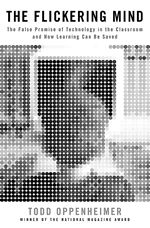
The Flickering Mind: The False Promise of Technology in the Classroom and How Learning Can Be Saved
By Todd Oppenheimer
Random House, 2003, $26.95; 512 pgs.
Reviewed by Brian Nelson
In 1997 Todd Oppenheimer published a widely read Atlantic Monthly article, “The Computer Delusion,” that painted a provocative portrait of technology’s failure to improve education thus far. The article outlined a long history of high expectations and underwhelming results and made Oppenheimer a well known if controversial figure in the field of education.
In The Flickering Mind, Oppenheimer amplifies his earlier theme by visiting schools around the country to get a firsthand glimpse of how technology is or is not working in schools. In general, Oppenheimer does not like what he sees. The Flickering Mind offers a grim image not only of educational technology but also of modern schooling altogether. Oppenheimer denounces a cast of anti-heroes who he claims, through duplicity or stupidity, are destroying education.
The lead villains in The Flickering Mind are the hardware and software companies that hawk their products to schools. Corporations such as Apple, IBM, and Microsoft are portrayed as “self-interested manipulators” out to swindle “naïve” administrators and “gullible” teachers by foisting worthless technology on them.
To Oppenheimer, the central crime perpetrated by these businesses seems to be the very fact that they are businesses; they charge something for their products. Oppenheimer frequently juxtaposes the marketing slogans-improved learning! students who love school!-against the costs of implementing and maintaining classroom technology. The implication is that because businesses have a financial interest in selling technology, their claims regarding the educational value of their products cannot be trusted. No doubt technology firms, primarily interested in earning a buck, can sometimes make overblown claims. Most, however, probably believe in their products and hope to make a positive difference.
Nevertheless, Oppenheimer does an excellent job of highlighting the futility of simply throwing money at a problem. In case after case, he finds that schools have spent huge sums on technology at the expense of more pressing needs. He ruefully recounts tales of gleaming computer labs in crumbling buildings, purchased with funds that could have gone to art, music, shop, and teachers’ salaries.
Oppenheimer derides schools that blow the budget on late-model computers and software with no thought to maintaining them or training teachers in how to use them. Maintenance of the machines often falls on a few harried technology workers who scramble from school to school or even a single enthusiastic teacher who operates as the default school network administrator, software buyer, and curriculum designer. New computer labs sit idle because overworked teachers have neither the time nor the training needed to make use of them.
These implementation problems are secondary, however, to Oppenheimer’s belief that technology actually has little role to play in schools. He argues that there are fundamental weaknesses in the curricula delivered through technology. At various points in the book, he dismisses technology-supported, project-based learning; collaborative group work; computer-based simulations; and Internet-based research. In the face of teachers’ happy claims, he sees only noisy “chaos.”
Oppenheimer’s opinions may reveal more about his personal outlook on modern education than about the value of technology in schools. Though he objects to this characterization, he clearly yearns to return to the education system of an idealized yesteryear. In one technology-heavy school, the only class Oppenheimer enjoys has a teacher lecturing to orderly rows of silent students, heads bent down and taking notes. He lauds aspects of project-based learning, but maligns it when it involves the use of technology.
For example, Oppenheimer admires traditional textbook-based research projects and “leafing methodically through a solid book,” but dismisses Internet-based research projects as lacking intellectual content. Material on the worldwide web, he claims, is often difficult to find, low in quality, and not easily understood by students. Furthermore, Oppenheimer complains that few of the PowerPoint presentations students design in lieu of more traditional paper-based reports show any depth or creativity. Where computers have failed, Oppenheimer hopes homespun projects featuring (among other things) knitting, pinecones, and homemade crayons will save the day.
Oppenheimer’s antipathy toward modern pedagogy is further reflected in the few uses of technology he finds effective. His vision for “how learning can be saved” boils down to using computers as supplemental tools in support of traditional, teacher-led classroom activities.
For example, he advocates a “one computer per classroom” approach, in which teachers carefully guide groups of students through software programs. While this approach has some benefits in keeping kids on task, Oppenheimer seems to support it primarily because it moves the teacher back to center stage and eliminates the inherent messiness of allowing students some measure of control over their own learning. Because he rejects the notion of a student-centered, collaborative pedagogy, Oppenheimer necessarily also rejects the use of technology to support such learning.
While Oppenheimer’s complaints about the poor quality of most software and computer-supported curricula are on target, it is difficult to place the blame on technology. When describing computer-based projects that are inventive and motivating, Oppenheimer is quick to point out that similar projects could be done without computers. But when discussing poor curriculum, he links low quality directly to technology. He can’t have it both ways. If good curriculum is good, with or without technology, the same must be true of bad curriculum.
Most day-to-day activities in regular classrooms are no more or less inspired than their technology-supported counterparts. The reality of public schooling in the United States is that it has always had to aim at the middle. In trying to help most students learn pretty well most of the time, outstanding curriculum is going to be the exception rather than the rule. The promise of educational technology, as yet unfilled, is that such exceptions can become the norm.
-Brian Nelson is a doctoral student and instructor in the Technology in Education program at the Harvard Graduate School of Education.


